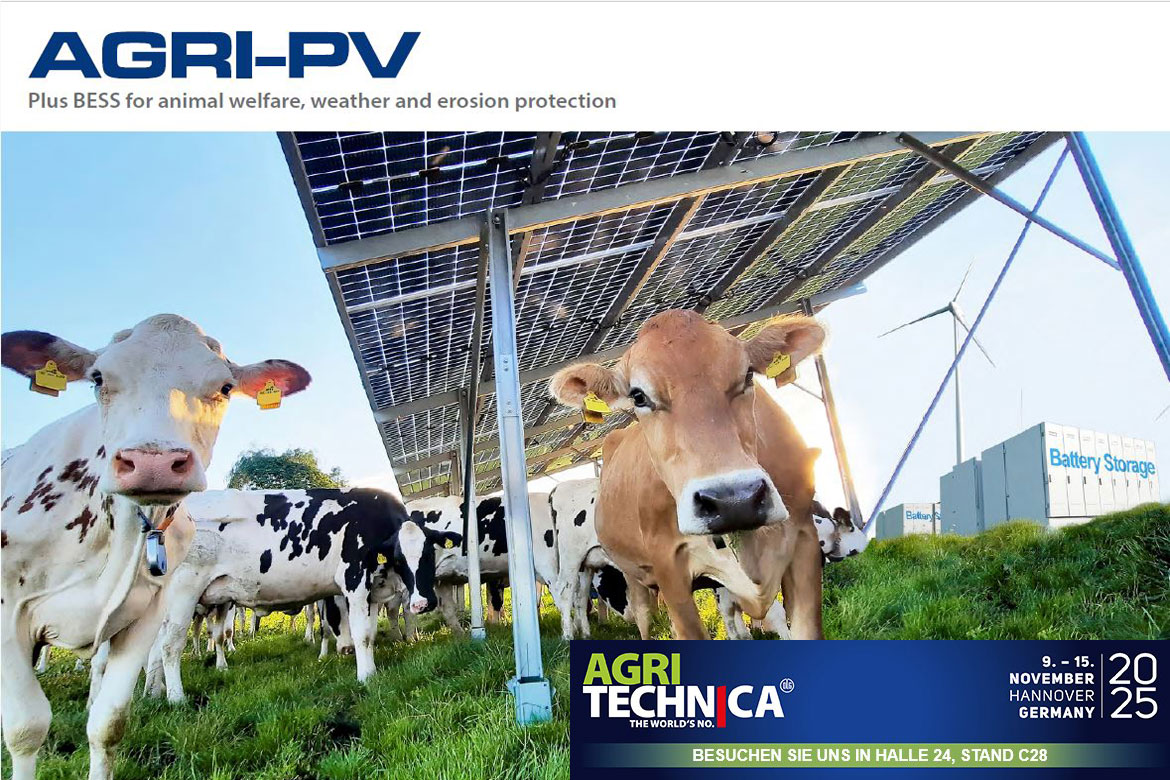Agri-photovoltaics: Agriculture and energy production grow together – SUNfarming at Agritechnica 2025
From November 9 to 15, 2025, SUNfarming will be presenting practical solutions and innovative systems related to the future-oriented topic of agri-photovoltaics (Agri-PV) at Agritechnica in Hanover, Hall 24, Booth C28.
The combination of agriculture and solar energy is considered a key technology for the sustainable transformation of the agricultural sector – and SUNfarming is one of the leading pioneers in this field.Efficient dual use: energy and yields from the same area
The great advantage of agri-PV lies in the simultaneous use of agricultural land for food production and energy generation. While the solar modules supply electricity, crops can be grown or animals kept underneath them. SUNfarming relies on flexible, modular systems that can be adapted to the needs of different crops and types of farming – from berries and medicinal plants to vegetable cultivation and animal husbandry.
“Our agri-PV systems offer protection from extreme weather conditions such as hail, heavy rain, and heat, while at the same time generating valuable green electricity,” explains Peter Schrum, founder of SUNfarming. “In this way, they not only contribute to climate protection, but also to the economic stability of agricultural businesses.”
Technological innovation: From rainwater management to robotics
At Agritechnica, SUNfarming will present the latest research results from its own Agri-PV Research and Innovation Center in Rathenow.
Here, various system designs, crops, and cultivation methods are tested under real conditions.
A key topic is the proven rainwater distribution system under the modules: Large-scale irrigation and the natural capillary action of the soil ensure even moisture distribution – a decisive factor for yield security and soil health.
Agri-robotics is also playing an increasingly important role: in Rathenow, autonomous robots for maintenance, irrigation, and harvesting are being tested in collaboration with start-ups. These technologies are intended to reduce the amount of work required while increasing precision in cultivation under PV systems.
New perspectives for animal husbandry and municipal energy supply
In addition to crop production, SUNfarming is also focusing on agri-PV in animal husbandry.
Covering outdoor areas with solar modules provides animals with shade and weather protection, improves animal welfare, and opens up additional sources of income for farms through electricity production.
n combination with biogas, wind power, and battery storage, sustainable energy concepts are created that can also contribute to municipal heat supply.
A current example is the Steinhöfel project, where SUNfarming is preparing to start construction of a large-scale agri-PV system in accordance with DIN SPEC 91434. With a planned output of 150 MWp, this is an important step towards a total of 2 GWp of installed agri-PV capacity by 2030.
SUNfarming at Agritechnica 2025
At Agritechnica, SUNfarming will present various model-scale agri-PV systems and current research results on crop production, animal husbandry, and combined energy production in Hall 24, Booth C28.
Visitors can obtain information directly from agri-PV experts about funding opportunities, technical solutions, and project development options.
Conclusion:
Agri-photovoltaics is much more than a new form of solar energy – it is a strategy for the future of agriculture, climate protection, and regional value creation.
With decades of experience and a clear focus on research and practice, SUNfarming stands for innovative, economical, and sustainable solutions that demonstrate that energy and agriculture belong together.
Comments are closed.
By loading the map, you accept Google's privacy policy.
Learn more




